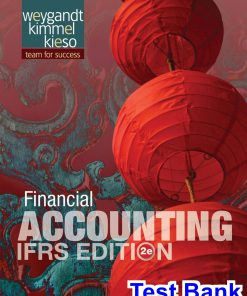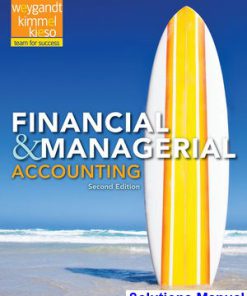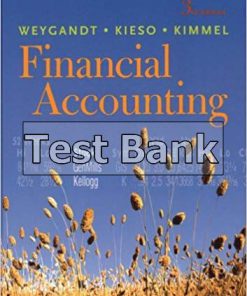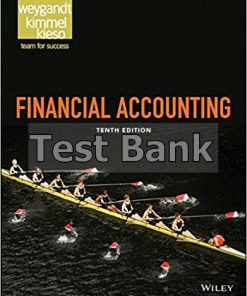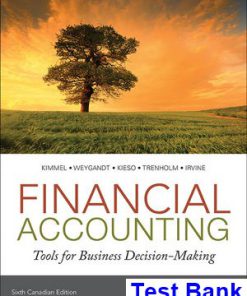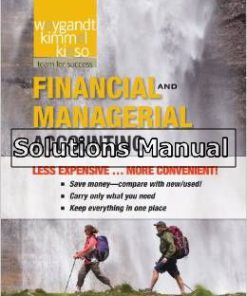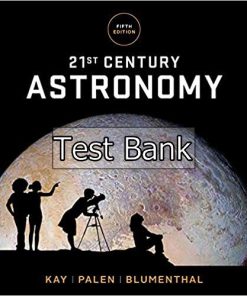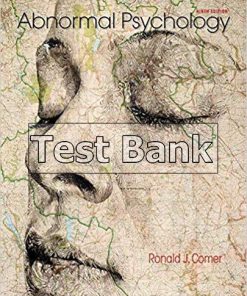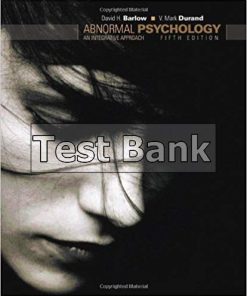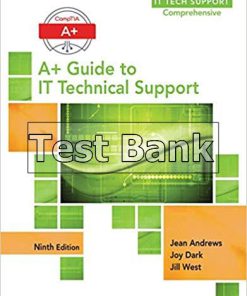Financial and Managerial Accounting 2nd Edition Weygandt Test Bank
$26.50$50.00 (-47%)
Financial and Managerial Accounting 2nd Edition Weygandt Test Bank.
You may also like
Instant download Financial and Managerial Accounting 2nd Edition Weygandt Test Bank pdf docx epub after payment.
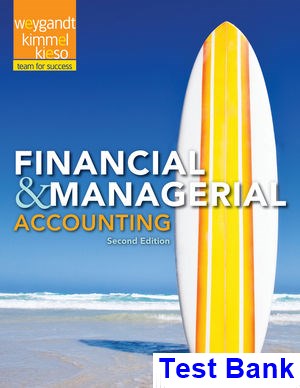
Product details:
- ISBN-10 : 1118338413
- ISBN-13 : 978-1118338414
- Author:
Financial and Managerial Accounting, Binder Ready Version 2nd Edition provides students with a clear introduction to fundamental accounting concepts. The Second Edition helps students get the most out of their accounting course by making practice simple. Newly streamlined learning objectives help students use their study time efficiently by creating a clear connections between the reading and video content, and the practice, homework, and assessments questions.
Weygandt, Financial and Managerial Accounting is ideal for a two-semester Financial and Managerial Accounting sequence where students spend equal time learning financial and managerial accounting concepts, and learn the accounting cycle from a corporate perspective. This program begins by introducing students to the building blocks of the accounting cycle and builds to financial statements. This is an unbound, binder-ready version. WileyPLUS sold separately from the text.
Table of contents:
1 Accounting in Action 2
Knowing the Numbers: Clif Bar 2
LO 1: Identify the activities and users associated with accounting 4
LO 2: Explain the building blocks of accounting: ethics, principles, and assumptions 7
LO 3: State the accounting equation, and define its components 12
LO 4: Analyze the effects of business transactions on the accounting equation 14
LO 5: Describe the four financial statements and how they are prepared 21
LO *6: APPENDIX 1A: Explain the career opportunities in accounting 25
A Look at IFRS 46
2 The Recording Process 48
Accidents Happen: MF Global Holdings 48
LO 1: Describe how accounts, debits, and credits are used to record business transactions 50
LO 2: Indicate how a journal is used in the recording process 55
LO 3: Explain how a ledger and posting help in the recording process 58
LO 4: Prepare a trial balance 69
A Look at IFRS 92
3 Adjusting the Accounts 94
Keeping Track of Groupons: Groupon 94
LO 1: Explain the accrual basis of accounting and the reasons for adjusting entries 96
LO 2: Prepare adjusting entries for deferrals 100
LO 3: Prepare adjusting entries for accruals 106
LO 4: Describe the nature and purpose of an adjusted trial balance 113
LO *5: APPENDIX 3A: Prepare adjusting entries for the alternative treatment of deferrals 117
LO *6: APPENDIX 3B: Discuss financial reporting concepts 120
A Look at IFRS 148
4 Completing the Accounting Cycle 150
Everyone Likes to Win: Rhino Foods 150
LO 1: Prepare a worksheet 152
LO 2: Prepare closing entries and a post-closing trial balance 157
LO 3: Explain the steps in the accounting cycle and how to prepare correcting entries 165
LO 4: Identify the sections of a classified balance sheet 168
LO *5: APPENDIX 4A: Prepare reversing entries 174
A Look at IFRS 200
5 Accounting for Merchandising Operations 204
Buy Now, Vote Later: REI 204
LO 1: Describe merchandising operations and inventory systems 206
LO 2: Record purchases under a perpetual inventory system 209
LO 3: Record sales under a perpetual inventory system 214
LO 4: Apply the steps in the accounting cycle to a merchandising company 218
LO 5: Compare a multiple-step with a single-step income statement 220
LO *6: APPENDIX 5A: Prepare a worksheet for a merchandising company 225
LO *7: APPENDIX 5B: Record purchases and sales under a periodic inventory system 227
A Look at IFRS 256
6 Inventories 258
“Where is That Spare Bulldozer Blade?”: Caterpillar 258
LO 1: Discuss how to classify and determine inventory 260
LO 2: Apply inventory cost flow methods and discuss their financial effects 264
LO 3: Indicate the effects of inventory errors on the financial statements 272
LO 4: Explain the statement presentation and analysis of inventory 274
LO *5: APPENDIX 6A: Apply the inventory cost flow methods to perpetual inventory records 277
LO *6: APPENDIX 6B: Describe the two methods of estimating inventories 280
A Look at IFRS 304
7 Fraud, Internal Control, and Cash 306
Minding the Money in Madison: Barriques 306
LO 1: Discuss fraud and the principles of internal control 308
LO 2: Apply internal control principles to cash 317
LO 3: Identify the control features of a bank account 325
LO 4: Explain the reporting of cash 333
A Look at IFRS 354
8 Accounting for Receivables 356
A Dose of Careful Management Keeps Receivables Healthy: Whitehall-Robins 356
LO 1: Explain how companies recognize accounts receivable 358
LO 2: Describe how companies value accounts receivable and record their disposition 360
LO 3: Explain how companies recognize notes receivable 369
LO 4: Describe how companies value notes receivable, record their disposition, and present and analyze receivables 371
A Look at IFRS 393
9 Plant Assets, Natural Resources, and Intangible Assets 396
How Much for a Ride to the Beach?: Rent-A-Wreck 396
LO 1: Explain the accounting for plant asset expenditures 398
LO 2: Apply depreciation methods to plant assets 402
LO 3: Explain how to account for the disposal of plant assets 409
LO 4: Describe how to account for natural resources and intangible assets 412
LO 5: Discuss how plant assets, natural resources, and intangible assets are reported and analyzed 417
LO *6: APPENDIX 9A: Explain how to account for the exchange of plant assets 419
A Look at IFRS 441
10 Liabilities 444
Financing His Dreams: Wilbert Murdock 444
LO 1: Explain how to account for current liabilities 446
LO 2: Describe the major characteristics of bonds 452
LO 3: Explain how to account for bond transactions 456
LO 4: Explain how to account for long-term notes payable 462
LO 5: Discuss how liabilities are reported and analyzed 464
LO *6: APPENDIX 10A: Apply the straight-line method of amortizing bond discount and bond premium 468
LO *7: APPENDIX 10B: Apply the effective-interest method of amortizing bond discount and bond premium 470
A Look at IFRS 495
11 Corporations: Organization, Stock Transactions, Dividends, and Retained Earnings 498
What’s Cooking?: Nike 498
LO 1: Discuss the major characteristics of a corporation 500
LO 2: Explain how to account for the issuance of common and preferred stock 509
LO 3: Explain how to account for treasury stock 512
LO 4: Explain how to account for cash dividends 515
LO 5: Explain how to account for stock dividends and splits 520
LO 6: Discuss how stockholders’ equity is reported and analyzed 524
LO *7: APPENDIX 11A: Describe the use and content of the stockholders’ equity statement 531
LO *8: APPENDIX 11B: Compute book value per share 531
A Look at IFRS 555
12 Investments 558
“Is There Anything Else We Can Buy?”: Time Warner 558
LO 1: Explain how to account for debt investments 560
LO 2: Explain how to account for stock investments 563
LO 3: Discuss how debt and stock investments are reported in financial statements 568
LO *4: APPENDIX 12A: Describe the form and content of consolidated financial statements as well as how to prepare them 575
A Look at IFRS 596
13 Statement of Cash Flows 598
Got Cash?: Microsoft 598
LO 1: Discuss the usefulness and format of the statement of cash flows 600
LO 2: Prepare a statement of cash flows using the indirect method 603
LO 3: Analyze the statement of cash flows 614
LO *4: APPENDIX 13A: Prepare a statement of cash flows using the direct method 616
LO *5: APPENDIX 13B: Use a worksheet to prepare the statement of cash flows using the indirect method 623
LO *6: APPENDIX 13C: Use the T-account approach to prepare a statement of cash flows 629
A Look at IFRS 656
14 Financial Statement Analysis 658
It Pays to Be Patient: Warren Buffett 658
LO 1: Apply horizontal and vertical analysis to financial statements 660
LO 2: Analyze a company’s performance using ratio analysis 666
LO 3: Apply the concept of sustainable income 678
A Look at IFRS 707
15 Managerial Accounting 710
Just Add Water and Paddle: Current Designs 710
LO 1: Identify the features of managerial accounting and the functions of management 712
LO 2: Describe the classes of manufacturing costs and the differences between product and period costs 716
LO 3: Demonstrate how to compute cost of goods manufactured and prepare financial statements for a manufacturer 720
LO 4: Discuss trends in managerial accounting 724
16 Job Order Costing 752
Profiting from the Silver Screen: Disney 752
LO 1: Describe cost systems and the flow of costs in a job order system 754
LO 2: Use a job cost sheet to assign costs to work in process 758
LO 3 : Demonstrate how to determine and use the predetermined overhead rate 763
LO 4 : Prepare entries for manufacturing and service jobs completed and sold 766
LO 5: Distinguish between under- and overapplied manufacturing overhead 771
17 Process Costing 794
LO 1: Discuss the uses of a process cost system and how it compares to a job order system 796
LO 2: Explain the flow of costs in a process cost system and the journal entries to assign manufacturing costs 799
LO 3: Compute equivalent units 802
LO 4: Complete the four steps to prepare a production cost report 805
LO *5: APPENDIX 17A: Compute equivalent units using the FIFO method 810
18 Activity-Based Costing 838
Precor is on Your Side 838
LO 1: Discuss the difference between traditional costing and activity-based costing 840
LO 2: Apply activity-based costing to a manufacturer 844
LO 3: Explain the benefits and limitations of activity-based costing 849
LO 4: Apply activity-based costing to service industries 854
LO *5: APPENDIX 18A: Explain just-in-time (JIT) processing 858
19 Cost-Volume-Profit 884
Don’t Worry—Just Get Big: Amazon.com 884
LO 1: Explain variable, fixed, and mixed costs and the relevant range 886
LO 2: Apply the high-low method to determine the components of mixed costs 890
LO 3: Prepare a CVP income statement to determine contribution margin 894
LO 4: Compute the break-even point using three approaches 898
LO 5: Determine the sales required to earn target net income and determine margin of safety 901
20 Cost-Volume-Profit Analysis: Additional Issues 922
Not Even a Flood Could Stop It: Whole Foods Market 922
LO 1: Apply basic CVP concepts 924
LO 2: Explain the term sales mix and its effects on break-even sales 929
LO 3: Determine sales mix when a company has limited resources 933
LO 4: Indicate how operating leverage affects profitability 935
LO *5: APPENDIX 20A: Explain the differences between absorption costing and variable costing 939
21 Incremental Analysis 972
Keeping It Clean: Method Products 972
LO 1: Describe management’s decision-making process and incremental analysis 974
LO 2: Analyze the relevant costs in accepting an order at a special price 977
LO 3: Analyze the relevant costs in a make-or-buy decision 979
LO 4: Analyze the relevant costs in determining whether to sell or process materials further 981
LO 5: Analyze the relevant costs to be considered in repairing, retaining, or replacing equipment 985
LO 6: Analyze the relevant costs in deciding whether to eliminate an unprofitable segment or product 986
22 Pricing 1012
They’ve Got Your Size—and Color: Zappos.com 1012
LO 1: Compute a target cost when the market determines a product price 1014
LO 2: Compute a target selling price using cost-plus pricing 1016
LO 3: Use time-and-material pricing to determine the cost of services provided 1020
LO 4: Determine a transfer price using the negotiated, cost-based, and market-based approaches 1024
LO *5: APPENDIX 22A: Determine prices using absorption-cost pricing and variable-cost pricing 1030
LO *6: APPENDIX 22B: Explain issues involved in transferring goods between divisions in different countries 1034
23 Budgetary Planning 1056
What’s in Your Cupcake?: BabyCakes NYC 1056
LO 1: State the essentials of effective budgeting and the components of the master budget 1058
LO 2: Prepare budgets for sales, production, and direct materials 1063
LO 3: Prepare budgets for direct labor, manufacturing overhead, and selling and administrative expenses, and a budgeted income statement 1068
LO 4: Prepare a cash budget and a budgeted balance sheet 1072
LO 5: Apply budgeting principles to nonmanufacturing companies 1077
24 Budgetary Control and Responsibility Accounting 1106
Pumpkin Madeleines and a Movie: Tribeca Grand Hotel 1106
LO 1: Describe budgetary control and static budget reports 1108
LO 2: Prepare flexible budget reports 1111
LO 3: Apply responsibility accounting to cost and profit centers 1118
LO 4: Evaluate performance in investment centers 1127
LO *5: APPENDIX 24A: Explain the difference between ROI and residual income 1131
25 Standard Costs and Balanced Scorecard 1158
80,000 Different Caffeinated Combinations: Starbucks 1158
LO 1: Describe standard costs 1160
LO 2: Determine direct materials variances 1165
LO 3: Determine direct labor and total manufacturing overhead variances 1169
LO 4: Prepare variance reports and balanced scorecards 1173
LO *5: APPENDIX 25A: Identify the features of a standard cost accounting system 1178
LO *6: APPENDIX 25B: Compute overhead controllable and volume variances 1181
26 Planning for Capital Investments 1204
Floating Hotels: Holland America Line 1204
LO 1: Describe capital budgeting inputs and apply the cash payback technique 1206
LO 2: Use the net present value method 1209
LO 3: Identify capital budgeting challenges and refinements 1214
LO 4: Use the internal rate of return method 1219
LO 5: Use the annual rate of return method 1222
A Specimen Financial Statements: Apple Inc A-1
B Specimen Financial Statements: PepsiCo, Inc B-1
C Specimen Financial Statements: The Coca-Cola Company C-1
D Specimen Financial Statements: Amazon.com, Inc D-1
E Specimen Financial Statements: Wal-Mart Stores, Inc E-1
F Specimen Financial Statements: Louis Vuitton F-1
G Time Value of Money G-1
LO 1: Compute interest and future values G-1
LO 2: Compute present values G-7
LO 3: Compute the present value in capital budgeting situations G-14
LO 4: Use a financial calculator to solve time value of money problems G-15
H Payroll Accounting* H-1
LO 1: Record the payroll for a pay period H-1
LO 2: Record employer payroll taxes H-7
LO 3: Discuss the objectives of internal control for payroll H-10
I Subsidiary Ledgers and Special Journals* I-1
LO 1: Describe the nature and purpose of a subsidiary ledger I-1
LO 2: Record transactions in special journals I-4
J Other Significant Liabilities* J-1
LO 1: Describe the accounting and disclosure requirements for contingent liabilities J-1
LO 2: Discuss the accounting for lease liabilities and off-balance-sheet financing J-3
LO 3: Discuss additional fringe benefits associated with employee compensation J-5
K Standards of Ethical Conduct for Management Accountants* K-1
IMA Statement of Ethical Professional Practice K-1
Cases for Managerial Decision-Making*
Company Index I-1
Subject Index I-5
People also search:
Financial and Managerial Accounting 2nd Edition
Financial and Managerial Accounting 2nd Edition pdf
Financial and Managerial Accounting
difference between financial and managerial accounting
financial and managerial accounting are similar in that both
financial and managerial accounting are similar in that

